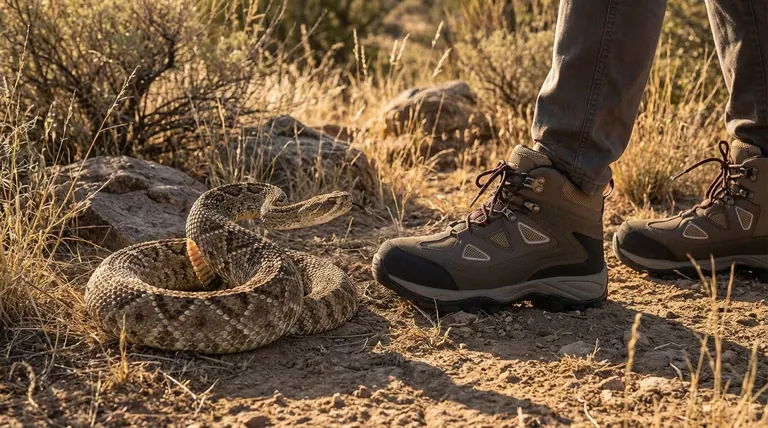Ultimately, four key factors determine if a snake can bite through leather boots: the snake's species and size, the length and strength of its fangs, the thickness of the leather, and the stiffness of the boot's material. While many snakes cannot penetrate a well-made leather boot, larger venomous species like rattlesnakes and copperheads can and do.
While standard leather boots offer a degree of incidental protection, they are not a reliable safeguard against the fangs of a large, motivated venomous snake. True protection comes from understanding the specific risks of your environment and choosing footwear designed to mitigate them.

Key Factors Influencing Penetration
A snake's ability to puncture a boot is a contest between the force of its strike and the resistance of the material. Several variables determine the outcome of this interaction.
The Snake's Species and Size
The most critical factor is the snake itself. A small, non-venomous snake has tiny teeth that pose no threat to leather.
However, larger venomous snakes, particularly those over 2.5 feet long, are a different matter. Species like copperheads and rattlesnakes have evolved to deliver venom through longer, stronger fangs designed to pierce hide.
Leather Thickness and Stiffness
The boot's material is the next line of defense. Thicker and stiffer leather provides significantly more protection than thin, pliable leather.
The dense and rigid structure of thick leather helps to stop a fang's momentum before it can achieve a full puncture. Softer leathers, while comfortable, offer far less resistance.
Boot Construction and Height
The overall design of the boot plays a crucial role in protection. Higher shafts, which often reach toward the knee, are essential for guarding the calf area against strikes.
Many strikes occur above the ankle, making standard-height work boots or hiking shoes insufficient for comprehensive protection in snake-prone areas.
Understanding the Trade-offs: Standard Leather vs. Snake-Proof Boots
Not all boots are created equal, and it's vital to understand the design intent behind your footwear. Relying on a standard boot for specialized protection can create a false sense of security.
The Original Purpose of Cowboy Boots
Many people assume traditional cowboy boots are effective against snakes. However, these boots were originally designed to protect a rider's leg from the saddle, not for walking through snake-infested terrain.
Their leather thickness, stiffness, and overall quality vary dramatically between brands, meaning their protective capability is incidental, not guaranteed.
Why Purpose-Built Boots Are Different
Dedicated snake-proof boots are engineered specifically to stop a fang strike. They are not just made of thick leather.
These boots often incorporate layers of materials like neoprene, rubber, or synthetic weaves designed to deflect or absorb the sharp, high-speed impact of a snake's fangs. They are rigorously tested for this exact purpose.
Making the Right Choice for Your Goal
Selecting the right footwear depends entirely on a realistic assessment of your environment and the potential risks you face.
- If your primary focus is casual hiking on well-maintained trails: A pair of high-quality, thick leather hiking boots offers a reasonable level of protection against smaller snakes.
- If you are relying on standard cowboy boots: Acknowledge that their protection is variable and uncertified; they are not a substitute for snake boots in high-risk areas.
- If you are working or exploring in tall grass, swamps, or known venomous snake habitats: Investing in certified snake-proof boots is the only way to ensure reliable protection.
Your safety depends on matching your equipment to your environment, and choosing the right boot provides true peace of mind.
Summary Table:
| Factor | Key Insight |
|---|---|
| Snake Species & Size | Larger venomous snakes (e.g., rattlesnakes) have fangs strong enough to penetrate. |
| Leather Thickness & Stiffness | Thick, rigid leather offers far more protection than thin, pliable leather. |
| Boot Construction & Height | Higher shafts (closer to the knee) protect against common calf-level strikes. |
| Purpose of the Boot | Standard boots offer incidental protection; certified snake boots are engineered to stop fangs. |
Don't compromise on safety. As a large-scale manufacturer, 3515 produces a comprehensive range of durable footwear, including heavy-duty leather and specialized safety boots for distributors, brand owners, and bulk clients. Whether you need reliable work boots for general use or are exploring specialized protective options, our production capabilities can meet your needs. Contact our team today to discuss your footwear requirements and ensure your workforce is properly equipped.
Visual Guide

Related Products
- Safety Footwear Wholesale Manufacturer for Custom OEM/ODM Production
- Wholesale Safety Footwear Manufacturer for Bulk & Custom OEM Orders
- Premium Grain Leather Safety Boots for Bulk Supply
- Premium Wholesale Waterproof Safety Boots High Performance Protection for Industrial Markets
- Customizable Anti-Smash Safety Boots for Wholesale & Private Label Manufacturing
People Also Ask
- How long can you wear safety boots? The Lifespan is Determined by Wear, Not Time
- What are the differences between steel toe, composite toe, and alloy toe Wellington boots? Choose the Right Safety Toe for Your Job
- What do heavy duty boots do? Protect Your Feet in Demanding Work Environments
- Is safety-toe as good as steel toe? Choose the Right Protection for Your Job
- What cultural and environmental considerations are tied to wearing shoes indoors? Balance Hygiene, Tradition, and Foot Health



















